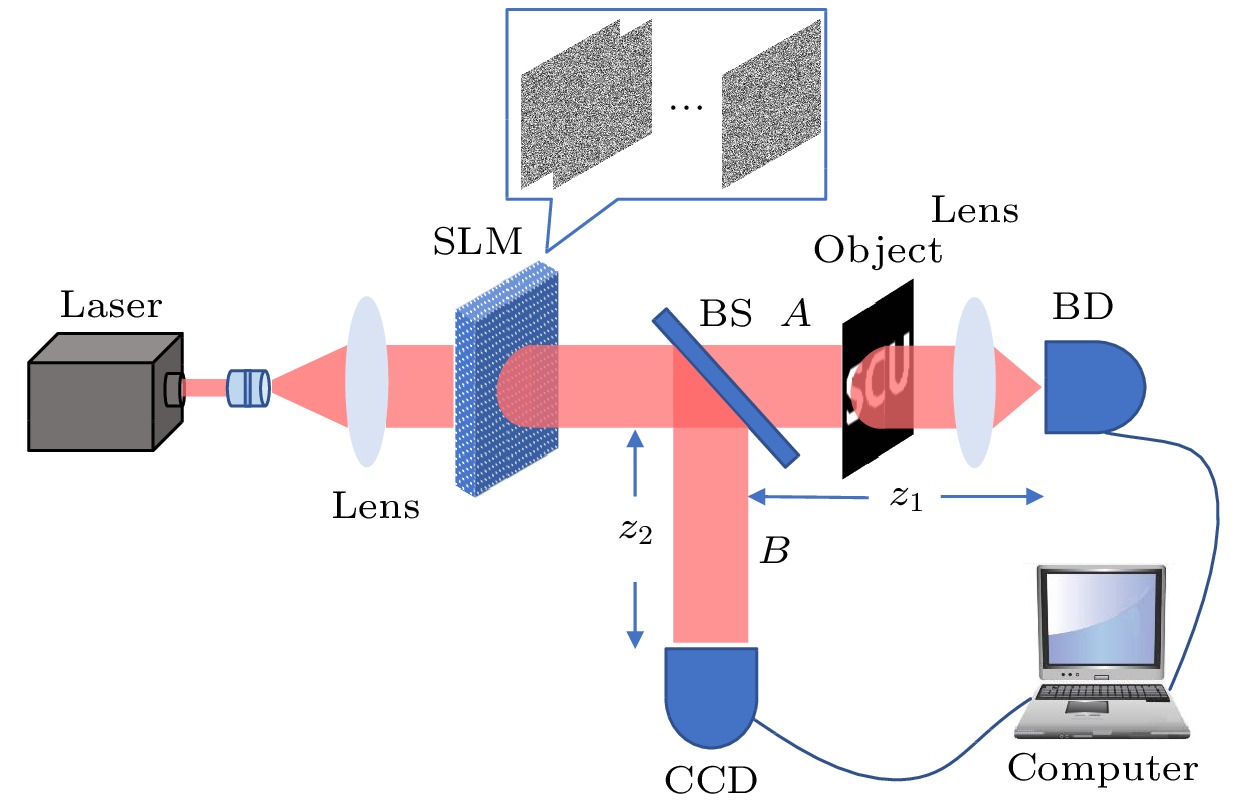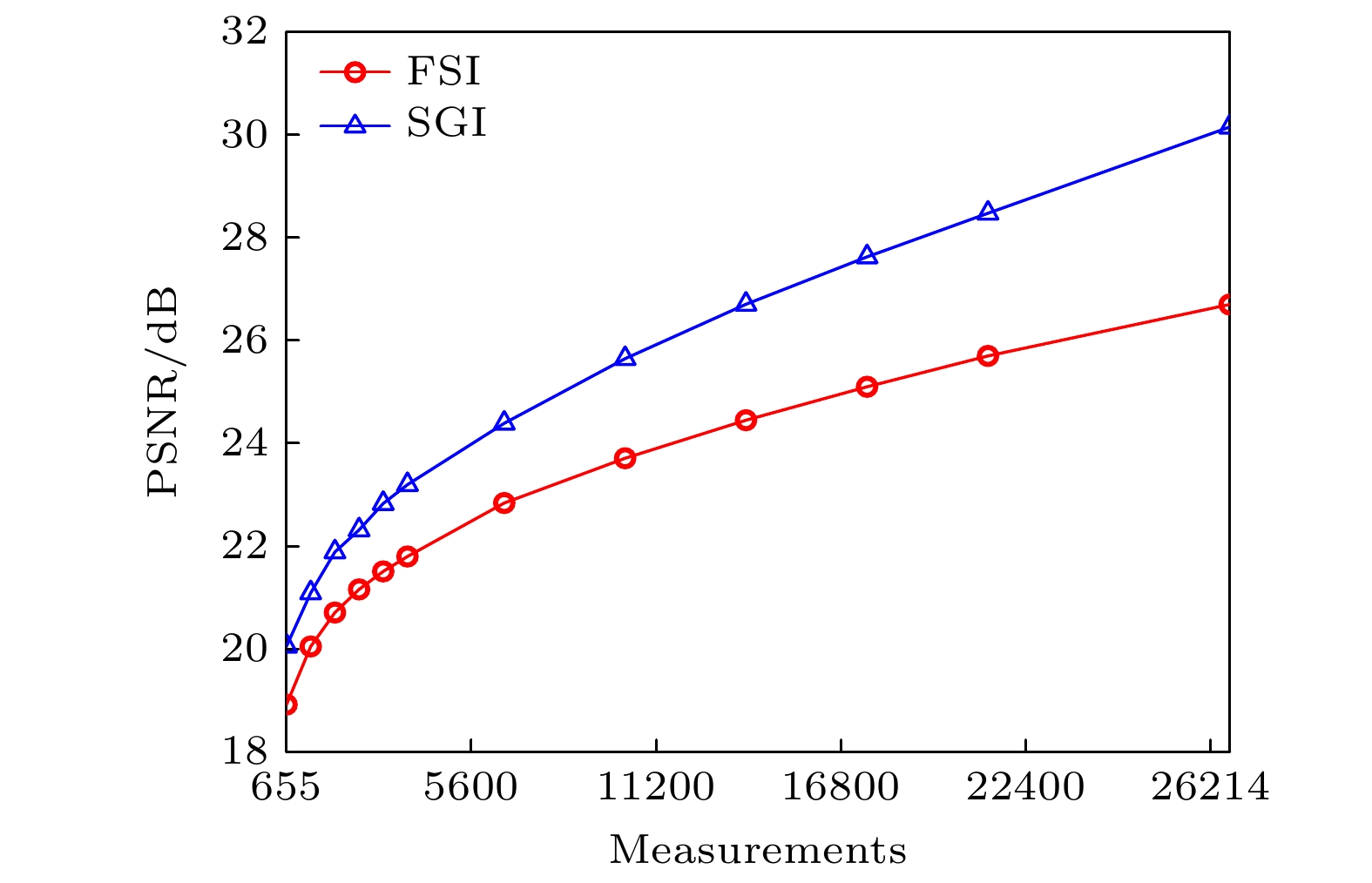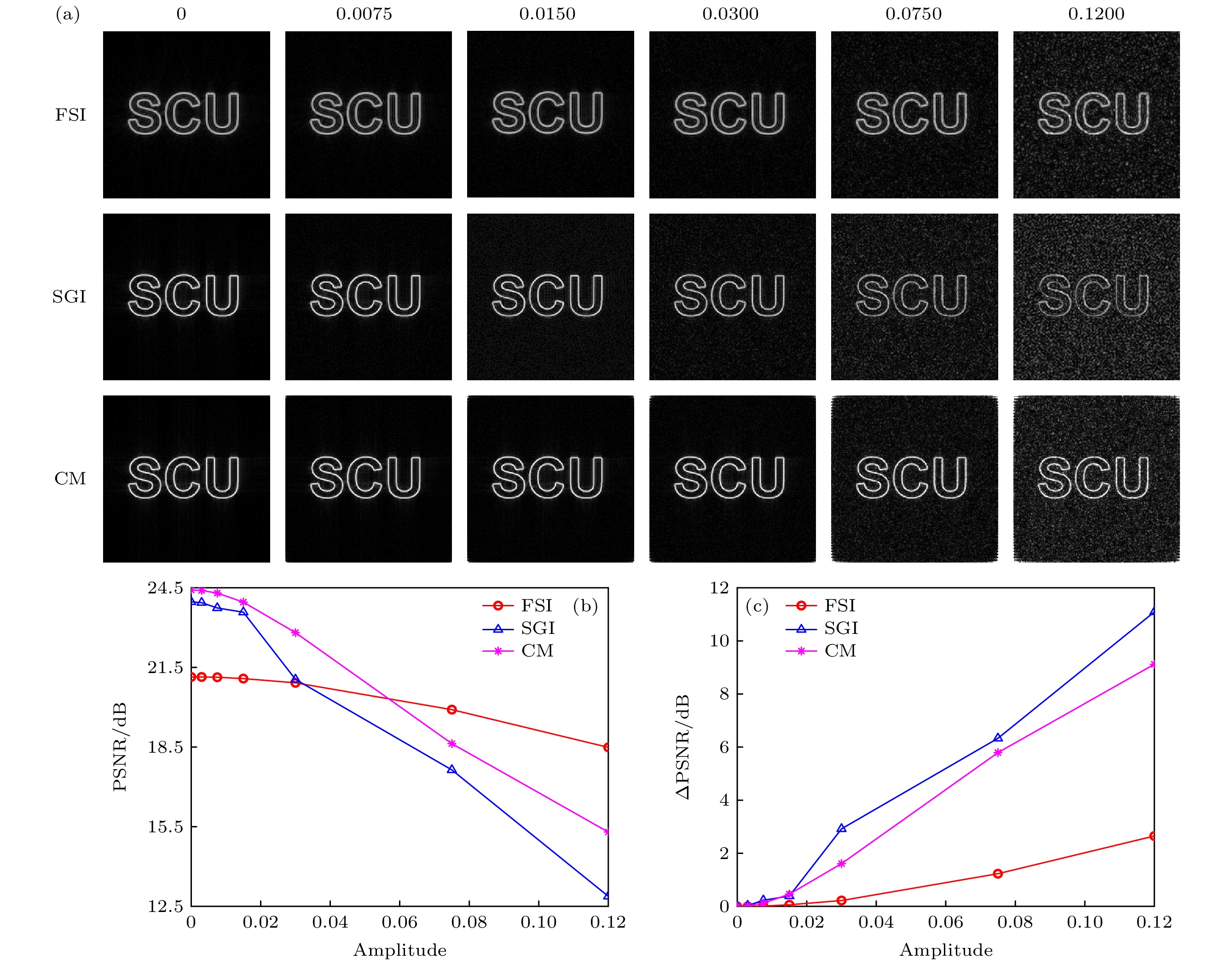-
Ghost imaging, also known as correlation imaging, is one of the research hotspots in the imaging field. Various ghost imaging systems with different basic principles and implementation architectures have emerged, but the correlation between them is weak, showing a diversified trend and recent research progress is slower than before. Studying the essence of ghost imaging theory is a feasible direction to explore the unknown field of ghost imaging. Through research, we find that Fourier ghost imaging and sinusoidal ghost imaging are based on the same type of orthogonal sine speckle and cosine speckle, which have a very high similarity. At the same time, sinusoidal ghost imaging method can give a complete spatial description and spatial imaging process, so we guess that these two imaging methods can reveal the relationship between spatial imaging and Fourier domain imaging. On this basis, it is proved that Fourier ghost imaging and sinusoidal ghost imaging are equivalent in principle. The former can be realized by n-step phase shift, while the latter can be equivalent to two-step phase shift. Considering that both of these methods use sine and cosine fringes as structural speckles. By combining the spatial decomposition characteristics of sine speckle imaging, the relationship between structural speckle imaging and traditional ghost imaging is analyzed, and the principles of some methods constructed on the basis of these two methods are explained. The simulation results applied to edge detection show that the combination of the two methods can simultaneously obtain the better anti-noise performance of Fourier ghost imaging and the higher imaging efficiency of sinusoidal ghost imaging. Since sinusoidal ghost imaging relates the characteristics of image spatial decomposition to traditional ghost imaging, and their expression is equivalent to the expression of orthogonal Fourier transform domain of Fourier ghost imaging, the association of ghost imaging methods in Fourier domain and even in the whole orthogonal transform domain and spatial domain can be generalized. This conclusion may provide a way for associating different kinds of ghost imaging, and it can be hoped that more and more new types of ghost imaging systems will be developed.
-
Keywords:
- ghost imaging /
- Fourier transform /
- orthogonal transformation space /
- phase shift algorithm
[1] Welsh S S, Edgar M P, Jonathan P, Sun B Q, Padgett M J 2013 Conference on Emerging Digital Micromirror Device Based Systems and Applications V San Francisco, CA, Feb. 05–06, 2013 p1
[2] Shapiro J H 2008 Phys. Rev. A 78 061802
 Google Scholar
Google Scholar
[3] Erkmen B I, Shapiro J H 2010 Adv. Opt. Photonics 2 405
 Google Scholar
Google Scholar
[4] Pittman T B, Shih Y H, Strekalov D V, Sergienko A V 1995 Phys. Rev. A 52 R3429
 Google Scholar
Google Scholar
[5] Bennink R S, Bentley S J, Boyd R W 2002 Phys. Rev. Lett. 89 113601
 Google Scholar
Google Scholar
[6] Cao D Z, Xiong J, Wang K 2005 Phys. Rev. A 71 013801
 Google Scholar
Google Scholar
[7] Edgar M P, Gibson G M, Bowman R W, Sun B, Radwell N, Mitchell K J, Welsh S S, Padgett M J 2015 Sci. Rep. 5 10669
 Google Scholar
Google Scholar
[8] Chan W L, Charan K, Takhar D, Kelly K F, Baraniuk R G, Mittleman D M 2008 Appl. Phys. Lett. 93 121105
 Google Scholar
Google Scholar
[9] Tajahuerce E, Duran V, Clemente P, Irles E, Soldevila F, Andres P, Lancis J 2014 Opt. Express 22 16945
 Google Scholar
Google Scholar
[10] Ferri F, Magatti D, Lugiato L A, Gatti A 2010 Phys. Rev. Lett. 104 253603
 Google Scholar
Google Scholar
[11] Wu L A, Luo K H 2011 S. N. Bose National Centre for Basic Sciences Silver Jubilee Symposium on 75 Years of Quantum Entanglement-Foundations and Information Theoretic Applications Kolkata, INDIA, Jan 06–10, 2011 p223
[12] Sun B Q, Welsh S S, Edgar M P, Shapiro J H, Padgett M J 2012 Opt. Express 20 16892
 Google Scholar
Google Scholar
[13] Zhang Z B, Ma X, Zhong J G 2015 Nat. Commun. 6 6225
 Google Scholar
Google Scholar
[14] Khamoushi S M M, Nosrati Y, Tavassoli S H 2015 Opt. Lett. 40 3452
 Google Scholar
Google Scholar
[15] Radwell N, Mitchell K J, Gibson G M, Edgar M P, Bowman R, Padgett M J 2014 Optica 1 285
 Google Scholar
Google Scholar
[16] Ortega A, Frossard P, Kovacevic J, Moura J M F, Vandergheynst P 2018 P. Ieee. 106 808
 Google Scholar
Google Scholar
[17] Bromberg Y, Katz O, Silberberg Y 2009 Phys. Rev. A 79 053840
 Google Scholar
Google Scholar
[18] Bian L H, Suo J L, Hu X M, Chen F, Dai Q H 2016 J. Optics-UK. 18 085704
 Google Scholar
Google Scholar
[19] 郑一瑶 2021 硕士学位论文 (西安: 西安理工大学)
Zheng Y Y 2021 M. S. Thesis (Xian: Xi’an University of Technology) (in Chinese)
[20] Khamoushi S M M, Tavassoli S H 2019 J. Optics-UK. 21 025702
 Google Scholar
Google Scholar
[21] Zhang Z B, Wang X Y, Zheng G A, Zhong J G 2017 Sci. Rep. 7 12029
 Google Scholar
Google Scholar
[22] Meng W W, Shi D F, Huang J, Yuan K E, Wang Y J, Fan C Y 2019 Opt. Express. 27 31490
 Google Scholar
Google Scholar
[23] Rousset F, Ducros N, Farina A, Valentini G, D'Andrea C, Peyrin F 2017 IEEE T. Comput. Imag. 3 36
[24] Liu B L, Yang Z H, Liu X, Wu L A 2017 J. Mod. Optic. 64 259
 Google Scholar
Google Scholar
[25] Wang L, Zhao S M 2016 Photonics Res. 4 240
 Google Scholar
Google Scholar
-
图 6 灰度FSI和SGI在叠加不同强度随机噪声下的重建结果, 随机噪声幅值的浮动范围分别为图像低频部分模拟测量值最大浮动范围的0, 0.0075, 0.015, 0.03, 0.075, 0.12倍 (a) 两种方法在不同噪声水平下的最终重建图像; (b) 最终重建图像的PSNR值; (c) 最终图像与无噪声图像的PSNR差值
Figure 6. The reconstruction results of grayscale FSI and SGI under the superposition of random noise with different intensities, the floating range of random noise amplitude is 0, 0.0075, 0.015, 0.03, 0.075, 0.12 times of the maximum floating range of the simulated measurement value for the low frequency part of the image, respectively: (a) The final reconstructed image of the two methods under different noise levels; (b) PSNR value of the final reconstructed image; (c) PSNR difference between the final image and the noiseless image.
图 9 三种方法在叠加不同强度随机噪声下的重建结果, 随机噪声幅值的浮动范围分别为图像低频部分模拟测量值最大浮动范围的0, 0.0075, 0.015, 0.03, 0.075, 0.12倍 (a) 3种方法在不同噪声水平下的最终重建图像; (b) 最终重建图像的PSNR值; (c) 最终图像与无噪声图像的PSNR差值
Figure 9. Reconstruction results of the three methods under different intensities of random noise. The floating range of random noise amplitude is 0, 0.0075, 0.015, 0.03, 0.075, 0.12 times of the maximum floating range of the simulated measurement value for the low frequency part of the image: (a) Final reconstructed images of the three methods under different noise levels; (b) PSNR value of the final reconstructed image; (c) PSNR difference between the final image and the noiseless image.
-
[1] Welsh S S, Edgar M P, Jonathan P, Sun B Q, Padgett M J 2013 Conference on Emerging Digital Micromirror Device Based Systems and Applications V San Francisco, CA, Feb. 05–06, 2013 p1
[2] Shapiro J H 2008 Phys. Rev. A 78 061802
 Google Scholar
Google Scholar
[3] Erkmen B I, Shapiro J H 2010 Adv. Opt. Photonics 2 405
 Google Scholar
Google Scholar
[4] Pittman T B, Shih Y H, Strekalov D V, Sergienko A V 1995 Phys. Rev. A 52 R3429
 Google Scholar
Google Scholar
[5] Bennink R S, Bentley S J, Boyd R W 2002 Phys. Rev. Lett. 89 113601
 Google Scholar
Google Scholar
[6] Cao D Z, Xiong J, Wang K 2005 Phys. Rev. A 71 013801
 Google Scholar
Google Scholar
[7] Edgar M P, Gibson G M, Bowman R W, Sun B, Radwell N, Mitchell K J, Welsh S S, Padgett M J 2015 Sci. Rep. 5 10669
 Google Scholar
Google Scholar
[8] Chan W L, Charan K, Takhar D, Kelly K F, Baraniuk R G, Mittleman D M 2008 Appl. Phys. Lett. 93 121105
 Google Scholar
Google Scholar
[9] Tajahuerce E, Duran V, Clemente P, Irles E, Soldevila F, Andres P, Lancis J 2014 Opt. Express 22 16945
 Google Scholar
Google Scholar
[10] Ferri F, Magatti D, Lugiato L A, Gatti A 2010 Phys. Rev. Lett. 104 253603
 Google Scholar
Google Scholar
[11] Wu L A, Luo K H 2011 S. N. Bose National Centre for Basic Sciences Silver Jubilee Symposium on 75 Years of Quantum Entanglement-Foundations and Information Theoretic Applications Kolkata, INDIA, Jan 06–10, 2011 p223
[12] Sun B Q, Welsh S S, Edgar M P, Shapiro J H, Padgett M J 2012 Opt. Express 20 16892
 Google Scholar
Google Scholar
[13] Zhang Z B, Ma X, Zhong J G 2015 Nat. Commun. 6 6225
 Google Scholar
Google Scholar
[14] Khamoushi S M M, Nosrati Y, Tavassoli S H 2015 Opt. Lett. 40 3452
 Google Scholar
Google Scholar
[15] Radwell N, Mitchell K J, Gibson G M, Edgar M P, Bowman R, Padgett M J 2014 Optica 1 285
 Google Scholar
Google Scholar
[16] Ortega A, Frossard P, Kovacevic J, Moura J M F, Vandergheynst P 2018 P. Ieee. 106 808
 Google Scholar
Google Scholar
[17] Bromberg Y, Katz O, Silberberg Y 2009 Phys. Rev. A 79 053840
 Google Scholar
Google Scholar
[18] Bian L H, Suo J L, Hu X M, Chen F, Dai Q H 2016 J. Optics-UK. 18 085704
 Google Scholar
Google Scholar
[19] 郑一瑶 2021 硕士学位论文 (西安: 西安理工大学)
Zheng Y Y 2021 M. S. Thesis (Xian: Xi’an University of Technology) (in Chinese)
[20] Khamoushi S M M, Tavassoli S H 2019 J. Optics-UK. 21 025702
 Google Scholar
Google Scholar
[21] Zhang Z B, Wang X Y, Zheng G A, Zhong J G 2017 Sci. Rep. 7 12029
 Google Scholar
Google Scholar
[22] Meng W W, Shi D F, Huang J, Yuan K E, Wang Y J, Fan C Y 2019 Opt. Express. 27 31490
 Google Scholar
Google Scholar
[23] Rousset F, Ducros N, Farina A, Valentini G, D'Andrea C, Peyrin F 2017 IEEE T. Comput. Imag. 3 36
[24] Liu B L, Yang Z H, Liu X, Wu L A 2017 J. Mod. Optic. 64 259
 Google Scholar
Google Scholar
[25] Wang L, Zhao S M 2016 Photonics Res. 4 240
 Google Scholar
Google Scholar
Catalog
Metrics
- Abstract views: 5255
- PDF Downloads: 117
- Cited By: 0















 DownLoad:
DownLoad:








